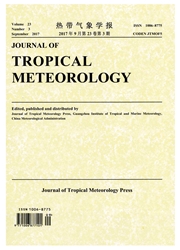

 中文摘要:
中文摘要:
The asymmetric distribution of convection associated with tropical cyclones making landfall on the east China coast is studied with black-body temperature (TBB) data from Fengyun-2 (FY-2) geostationary weather satellite. The convection in various quadrants of the TCs is examined for the period of -24 to 6 h relative to landfall. The convection to the southern side of the TCs was much more intense than that to the northern side during the whole landfall period. The convection to the western side of the TCs was stronger than that to the eastern side for the time -8 h before and at the landfall. After landfall, the situation reverses. The asymmetric convection of the TCs was partly due to the vertical wind shear and storm motion, and partly because the process of landfall restrained the convection in relevant quadrants. Besides, the orographic uplift along the east of China was favorable to the enhancement of convection in the eastern side of the TCs. From the characteristics of convective asymmetry of the TCs landing on the south and east of China, it is known that their main difference might be the included angle between the TC path and the coastline as well as the terrain along the coast.
 英文摘要:
英文摘要:
The asymmetric distribution of convection associated with tropical cyclones making landfall on the east China coast is studied with black-body temperature (TBB) data from Fengyun-2 (FY-2) geostationary weather satellite. The convection in various quadrants of the TCs is examined for the period of -24 to 6 h relative to landfall. The convection to the southern side of the TCs was much more intense than that to the northern side during the whole landfall period. The convection to the western side of the TCs was stronger than that to the eastern side for the time -8 h before and at the landfall. After landfall, the situation reverses. The asymmetric convection of the TCs was partly due to the vertical wind shear and storm motion, and partly because the process of landfall restrained the convection in relevant quadrants. Besides, the orographic uplift along the east of China was favorable to the enhancement of convection in the eastern side of the TCs. From the characteristics of convective asymmetry of the TCs landing on the south and east of China, it is known that their main difference might be the included angle between the TC path and the coastline as well as the terrain along the coast.
 同期刊论文项目
同期刊论文项目
 同项目期刊论文
同项目期刊论文
 期刊信息
期刊信息
